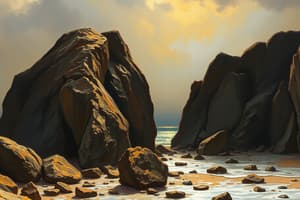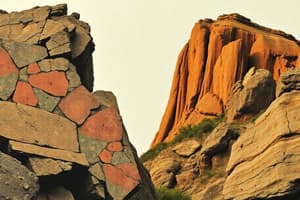Podcast
Questions and Answers
What type of metamorphism occurs when rock comes into contact with magma?
What type of metamorphism occurs when rock comes into contact with magma?
- Regional Metamorphism
- Hydrothermal Metamorphism
- Burial Metamorphism
- Contact Metamorphism (correct)
Which type of metamorphism is characterized by the alignment of minerals in bands due to significant pressure?
Which type of metamorphism is characterized by the alignment of minerals in bands due to significant pressure?
- Foliation (correct)
- Stratification
- Hydrothermal Metamorphism
- Burial Metamorphism
What type of rock results from burial metamorphism?
What type of rock results from burial metamorphism?
- New minerals
- Schist
- Compact rocks (correct)
- Marble
What is the primary cause of hydrothermal metamorphism?
What is the primary cause of hydrothermal metamorphism?
Which describes the main difference between stratification and foliation?
Which describes the main difference between stratification and foliation?
What is the first step in the rock cycle when a rock changes?
What is the first step in the rock cycle when a rock changes?
Which type of igneous rock cools quickest?
Which type of igneous rock cools quickest?
What causes clasts to become rounded?
What causes clasts to become rounded?
What defines a bioclastic rock?
What defines a bioclastic rock?
Which of the following statements is true about the formation of sedimentary rocks?
Which of the following statements is true about the formation of sedimentary rocks?
Which of these rocks is a clastic rock?
Which of these rocks is a clastic rock?
How does limestone form from water?
How does limestone form from water?
Which of the following characteristics distinguishes granite from rhyolite?
Which of the following characteristics distinguishes granite from rhyolite?
Flashcards are hidden until you start studying
Study Notes
The Rock Cycle
- Magma cools to form igneous rock
- Weathering and erosion break down rocks into sediment
- Sediment compacts to form sedimentary rock
- Heat and pressure transform sedimentary rock into metamorphic rock
- Metamorphic rock can melt back into magma, restarting the cycle
Igneous Rocks
- Extrusive igneous rocks form from rapidly cooled lava on the Earth's surface, resulting in small crystals
- Intrusive igneous rocks form from slowly cooled magma within the Earth, resulting in large crystals
Identifying Igneous Rocks
- Granite and rhyolite are intrusive, slow-cooling, and contain crystals
- Obsidian is extrusive, cools quickly on the surface, and lacks crystals, giving it a glassy appearance
Sedimentary Rocks
- Clasts are broken pieces of rock, rounded by water or wind erosion
- Sedimentary rocks form through:
- Rock breaking into sediment
- Sediment transport and deposition
- Compaction and cementation of sediment layers
Types of Sedimentary Rocks
- Clastic rocks are made of fragments from other rocks, such as sandstone
- Bioclastic rocks are composed of remnants of organisms, such as limestone (containing shells)
Other Rock Formation
- Halite (rock salt) forms from evaporated saltwater
- Limestone can form from calcium-rich water
Metamorphic Rocks
- Formed through different types of metamorphism:
- Contact Metamorphism: Result of rock touching magma, creating rocks like marble
- Regional Metamorphism: Deep underground pressure, resulting in rocks like schist
- Hydrothermal Metamorphism: Hot water interaction with rock, leading to new mineral formations
- Burial Metamorphism: Compaction from overlying rock layers
Distinguishing Rock Types
- Stratification in sedimentary rocks represents layers formed by settling sediment
- Foliation in metamorphic rocks are layers caused by pressure, aligning minerals in bands
- Banding in a rock indicates metamorphic formation due to mineral alignment from pressure
Studying That Suits You
Use AI to generate personalized quizzes and flashcards to suit your learning preferences.




